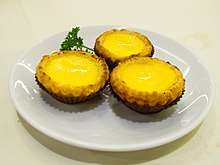Egg tart
 Egg tart | |
| Type | Pastry |
|---|---|
| Course | Dessert, snack |
| Serving temperature | Fresh from oven |
| Main ingredients | Flour, butter, sugar, egg, custard, milk |
| Egg tart | |||||||||||||||
| Traditional Chinese | 蛋撻 | ||||||||||||||
|---|---|---|---|---|---|---|---|---|---|---|---|---|---|---|---|
| Simplified Chinese | 蛋挞 | ||||||||||||||
| Literal meaning | egg tart | ||||||||||||||
| |||||||||||||||
The egg tart (commonly romanized as daahn tāat (Cantonese Yale: daan6 taat1), dàn tǎ (Mandarin), or dan tat) is a kind of custard tart found in Macau, Hong Kong, China, Taiwan, Portugal, Brazil, Britain, and various Asian countries. The dish consists of an outer pastry crust and is filled with egg custard and baked.
History
The English custard tart and the Portuguese pastel de nata are European forerunners of the Chinese egg tart, which displays characteristics of both. Before egg tart was introduced to Hong Kong, it is reported that it was first found in 1920s Guangzhou. Taking reference from the recipes of fruit tarts, the chefs in Guangzhou turned it into egg tarts by filling egg custards in the middle instead, a similar way to make simmered eggs with milk (燉蛋). However, as butter was very costly at that time, it was difficult for the chefs to make puff pastry for the tarts. Therefore, they may have used lard instead.
During the 1920s, as there was tough competition between department stores in attracting customers, the chef of each department store would invent a new dim sum or dessert weekly (每週美點) as an attraction. This was when egg tarts first appeared in Guangzhou. Later in the 1940s and 1950s, lots of the chefs migrated to Hong Kong and brought recipes with them. Hence, a Hong Kong style of egg tarts emerged.[1]
Custard tarts were first introduced in Hong Kong in the 1940s through cha chaan tengs. Hong Kong egg tarts are the adaptations of pastel de nata, popular in Macau. Canton (modern Guangdong) had more frequent contact with the West, particularly with Britain and Portugal, than the rest of China. Also, being a neighbour of Macau, Hong Kong has adopted some of the Macanese cuisine.
As well as egg tarts, there are also coconut tarts.
Categories
Guangzhou cuisine
Today, egg tarts are one of the more recognizable dim sum dishes offered in a dim sum house. In Guangzhou, there are 3 basic types of egg tarts: dan tat (egg tart), pastel de nata (Portuguese tart), coconut tart.
It is not only provided in yum cha, but also provided in bakeries.
Hong Kong cuisine
Today, egg tarts come in many variations within Hong Kong cuisine, including egg white, milk, honey-egg, ginger-flavoured egg, which are variations of a traditional milk custard and egg custard, and also chocolate tarts, green-tea-flavoured tarts, and even bird's nest tarts.
Overall, egg tarts have two main types of crusts: shortcrust pastry or puff pastry, traditionally made with lard rather than butter or shortening.[2] They are both filled with a rich custard that is much eggier and less creamy than English custard tarts.
Unlike English custard tarts, egg tarts are not sprinkled with ground nutmeg or cinnamon before serving.[3] It may also be served piping hot rather than at room temperature like English custard tarts.[4]
Chinese egg tarts can be found in Hong Kong, Macau, and other parts of China. There is a slight difference between Hong Kong and Macau versions. Macau's version was brought by Portuguese colonizers. The Portuguese egg tart made its way to Hong Kong, where it was influenced by British custard tarts. The Portuguese version tends to be less glassy and smooth.
Portuguese cuisine
The egg custard tarts are popular in many of the European countries too. Portuguese egg tarts evolved from "pastel de nata", a traditional Portuguese custard pastry that consists of a crème brûlée-like custard caramelized in a crust, as created over 200 years ago by monks at Jerónimos Monastery (Portuguese: Mosteiro dos Jerónimos) at Belém in Lisbon.[5] Casa Pastéis de Belém was the first pastry shop outside of the convent to sell this pastry in 1837. It is now a popular pastry in many pastry shops around the world owned by Portuguese descendants.
See also
References
- ↑ "除了奶茶,還有蛋撻 - 香港文匯報". paper.wenweipo.com. Retrieved 2017-02-02.
- ↑ "Behind the scenes of Hong Kong's most loved egg tart bakery". Hiufu Wong. CNN Travel. 2 August 2010. Retrieved 15 July 2013.
- ↑ "Cantonese Egg Tarts Recipe". Christine. Christine's Recipes. 25 March 2009. Retrieved 15 July 2013.
- ↑ "World's 50 best foods". CNN Travel. 21 July 2011. Retrieved 15 July 2013.
- ↑ csmonitor
External links
| Wikimedia Commons has media related to Egg tarts. |